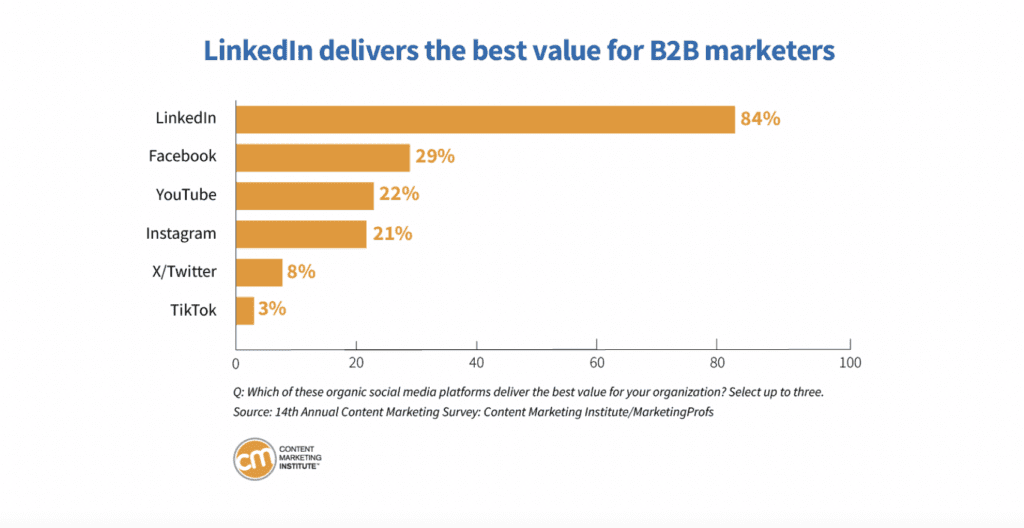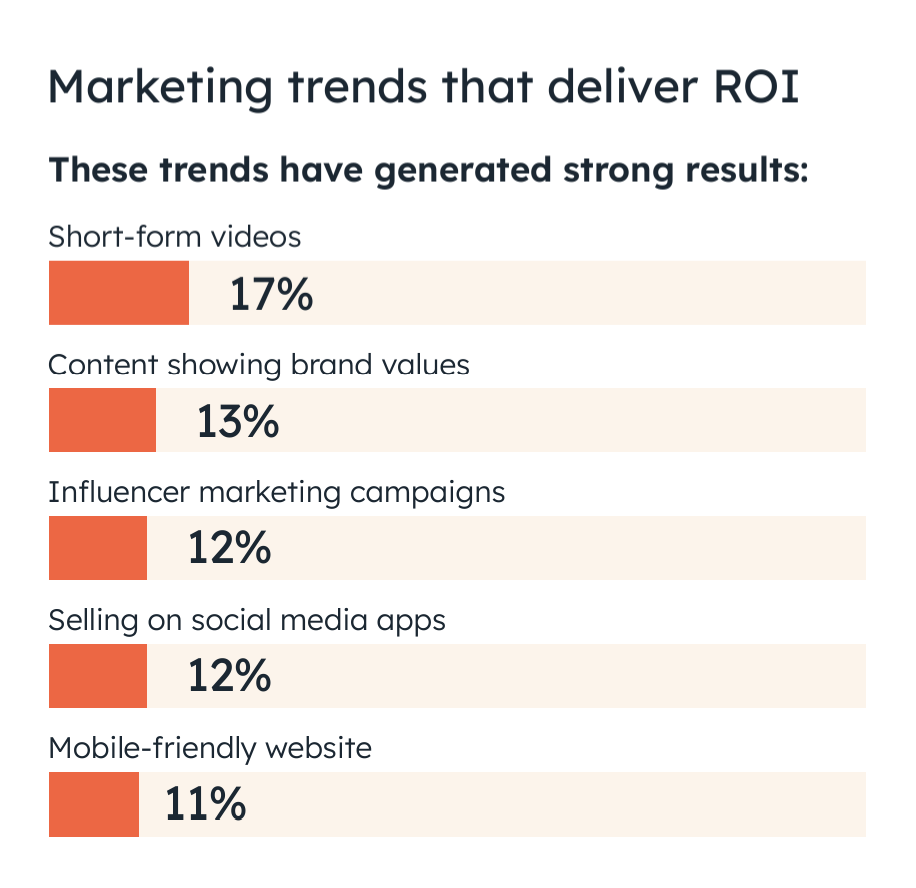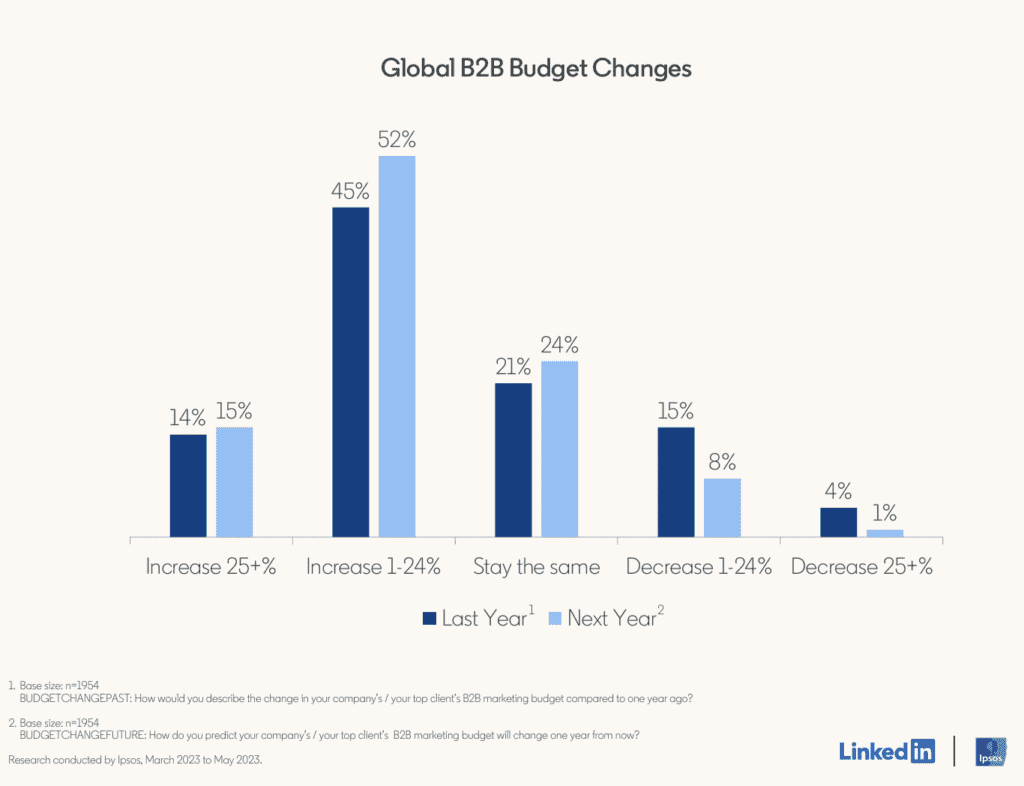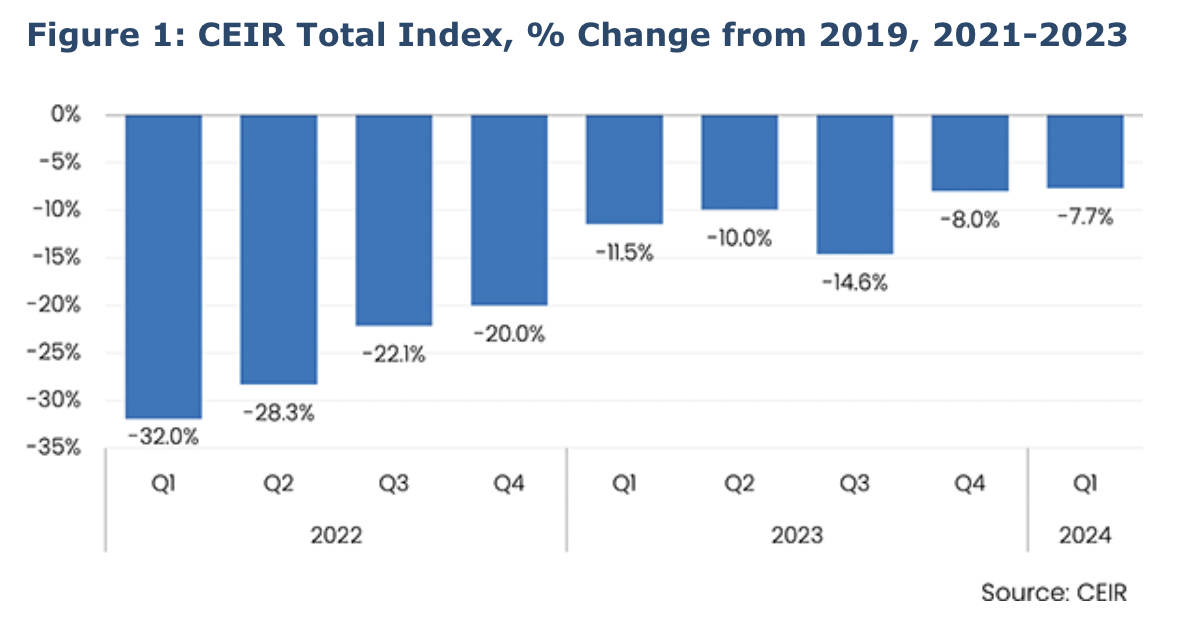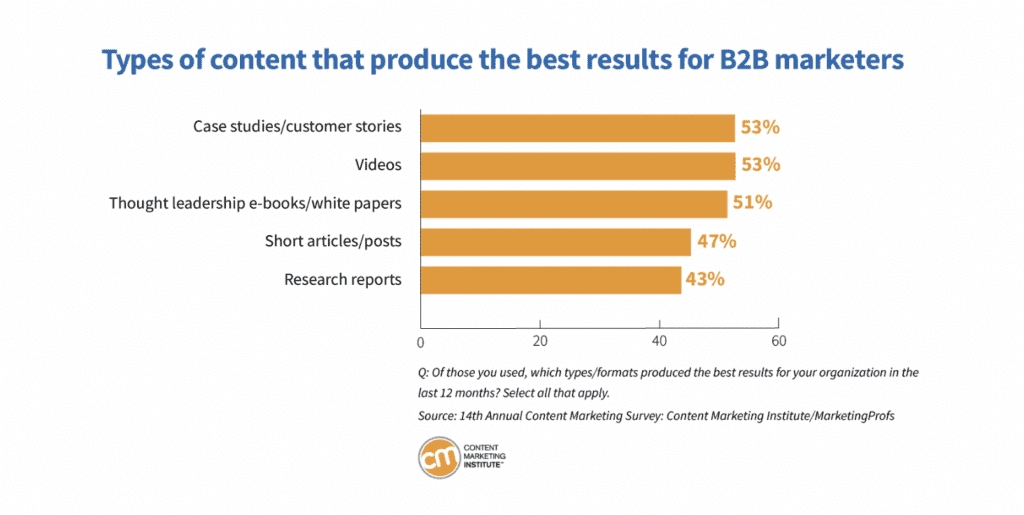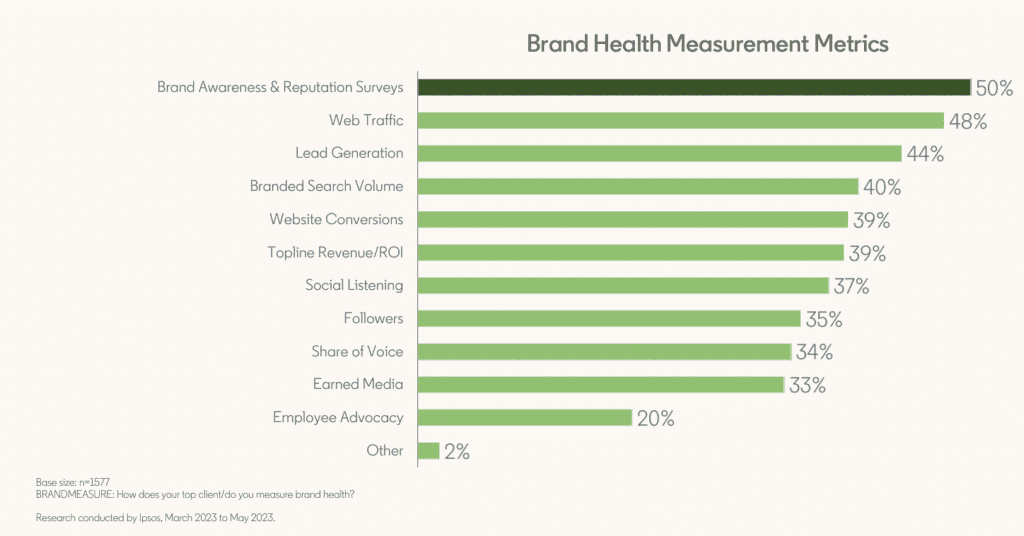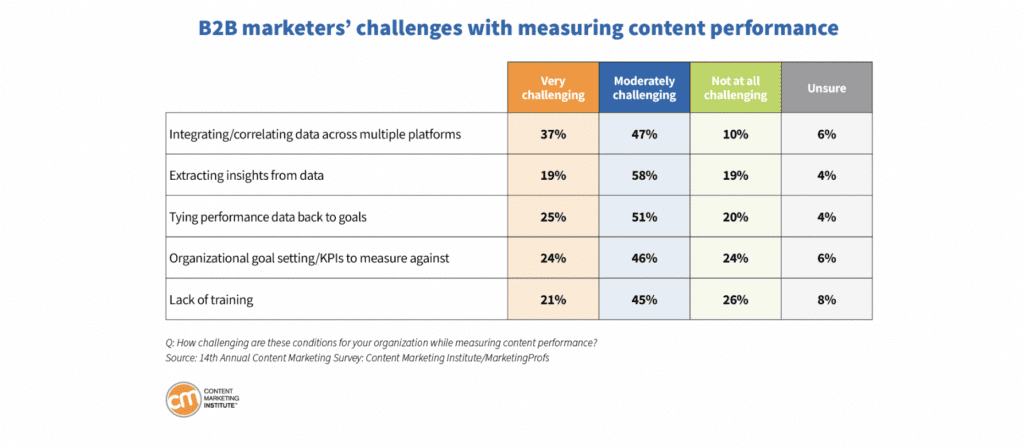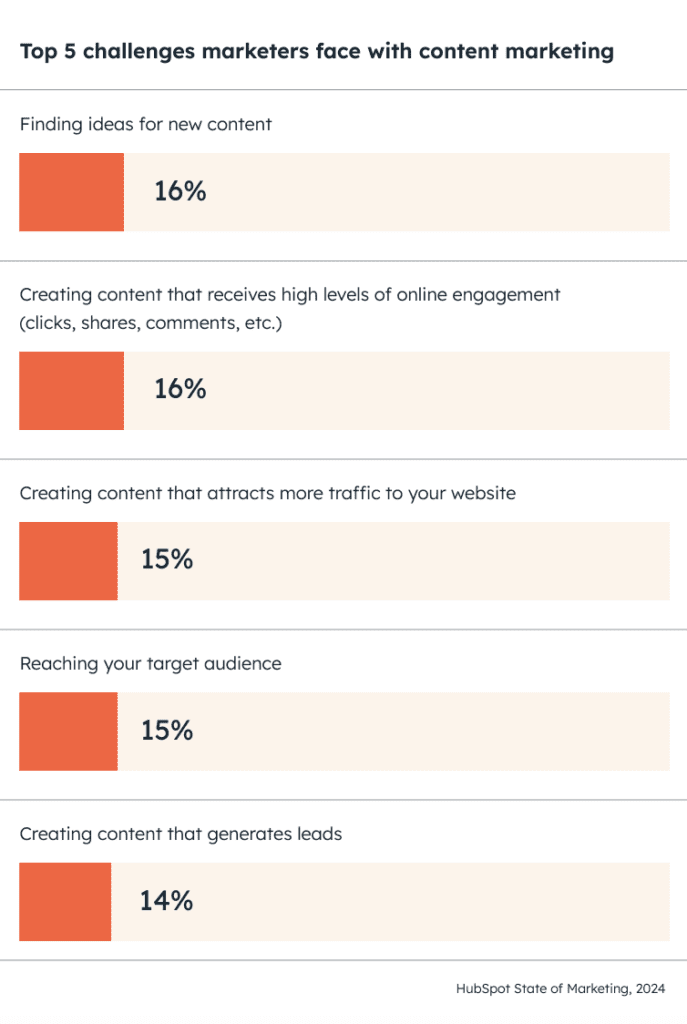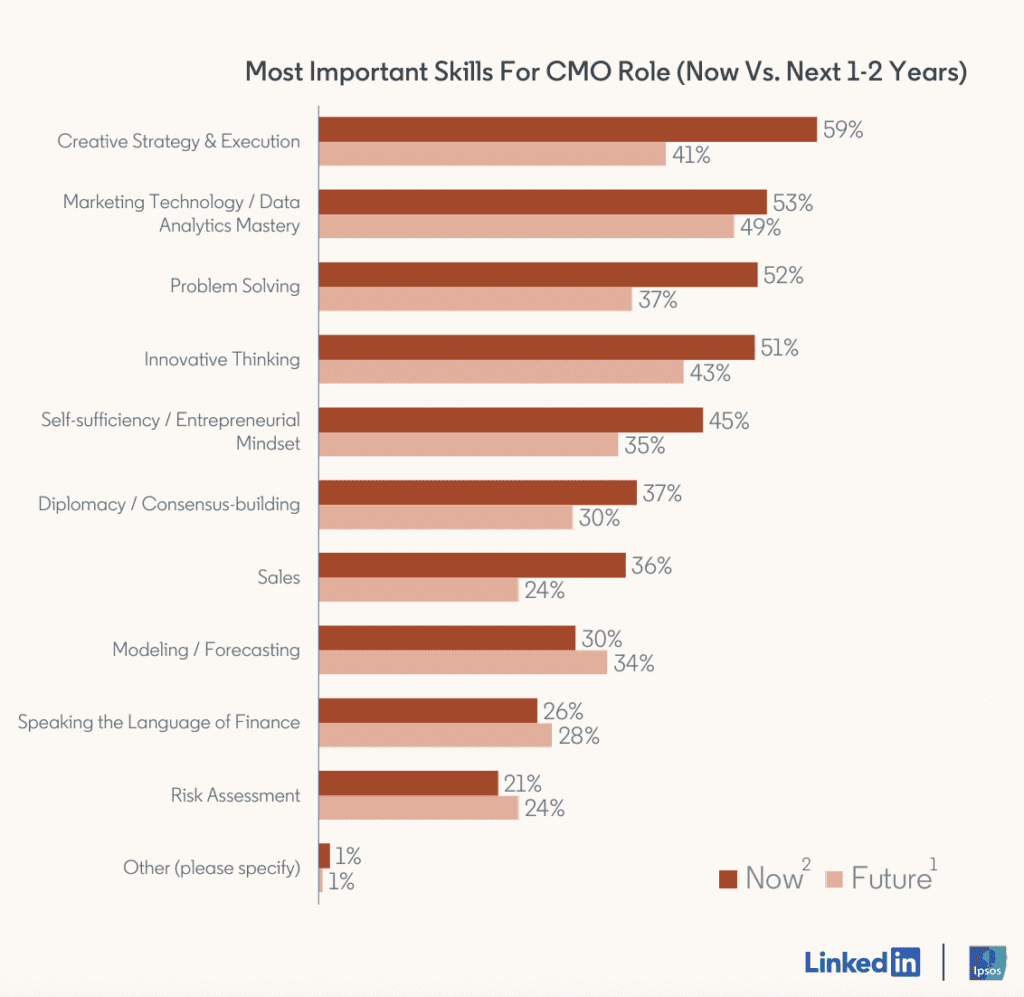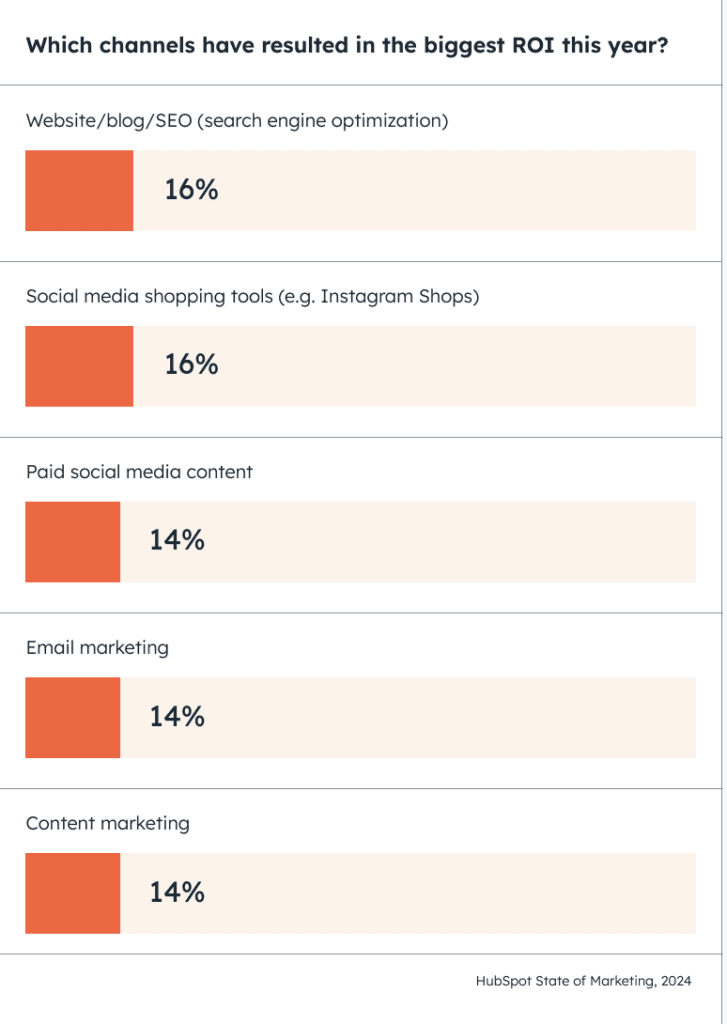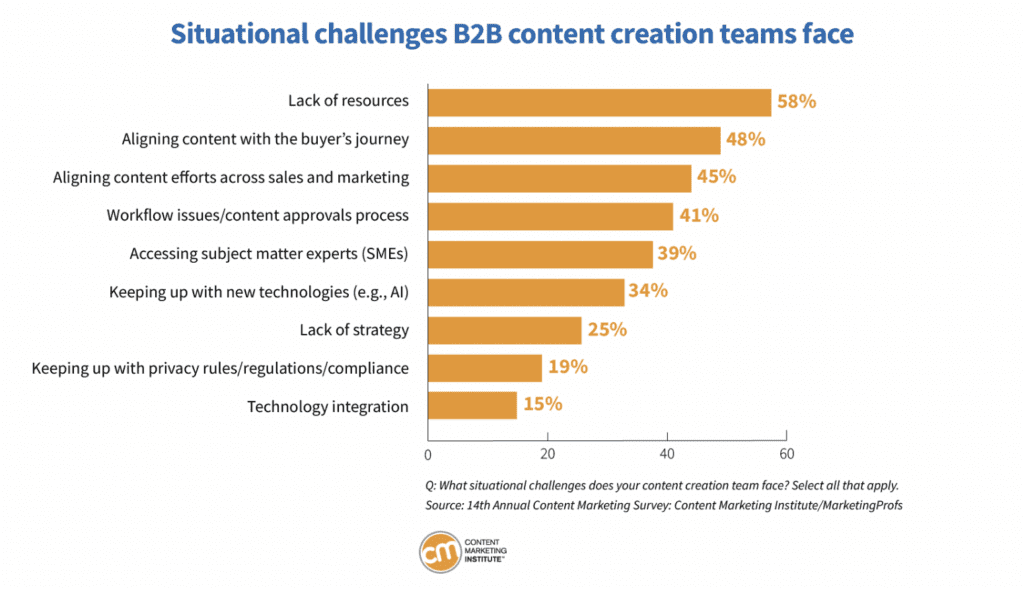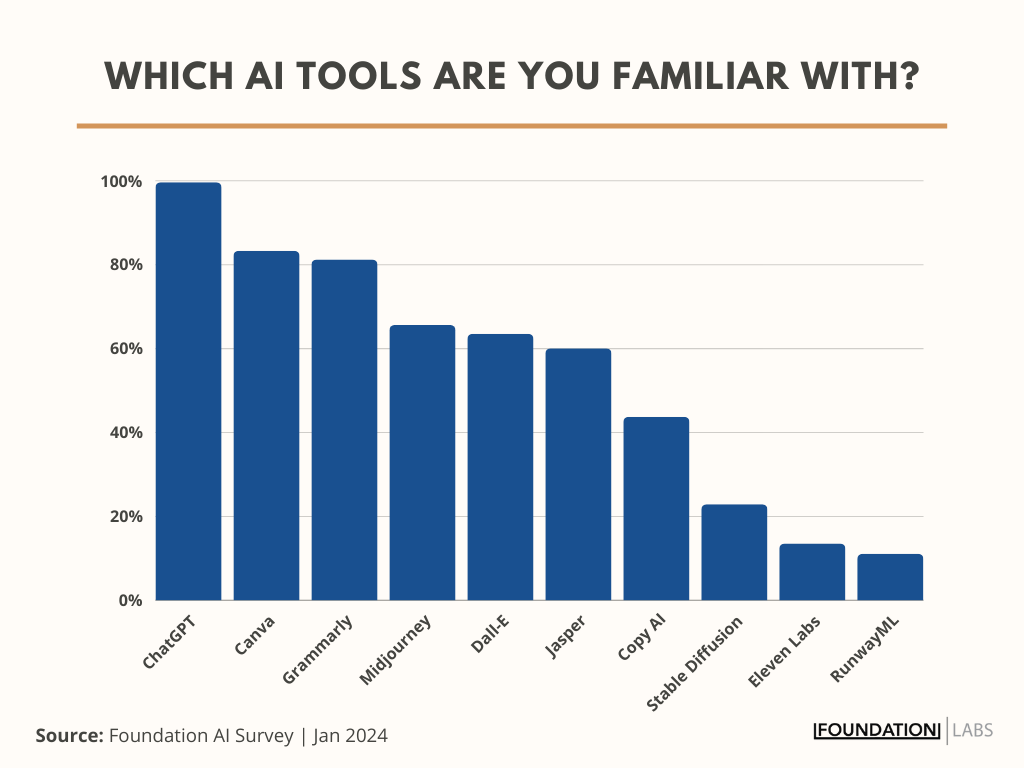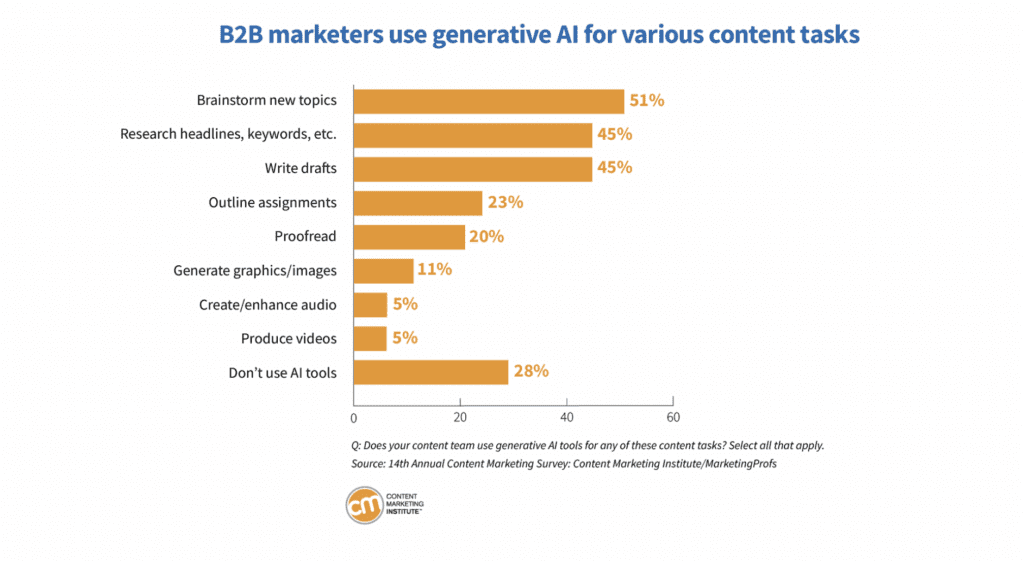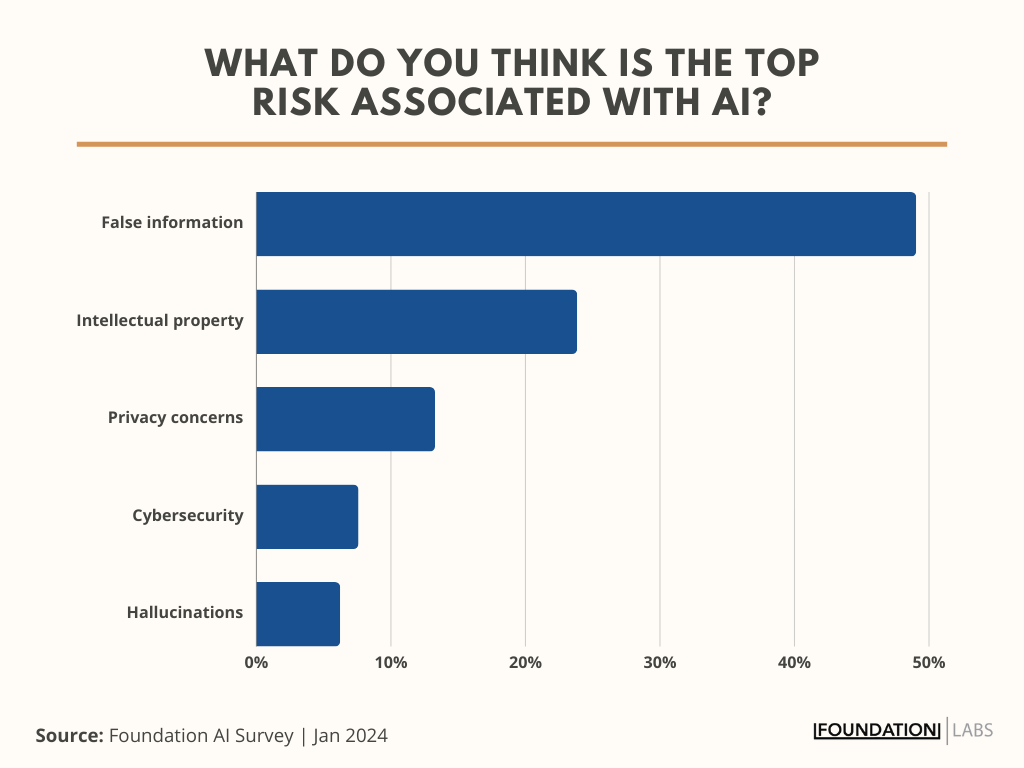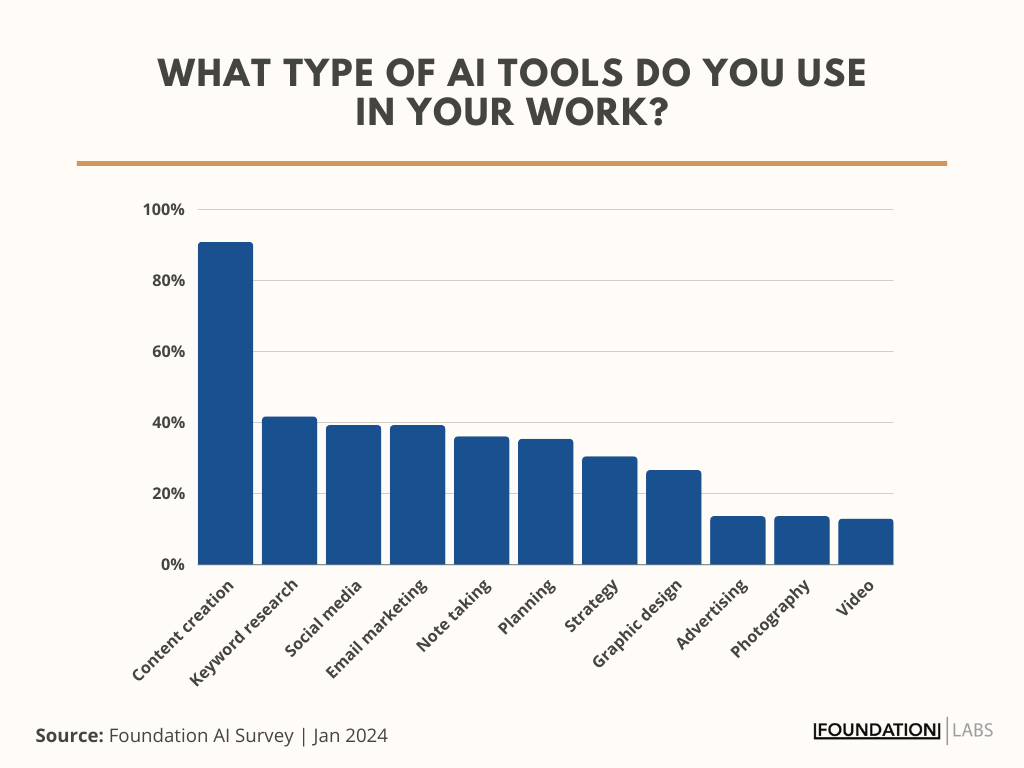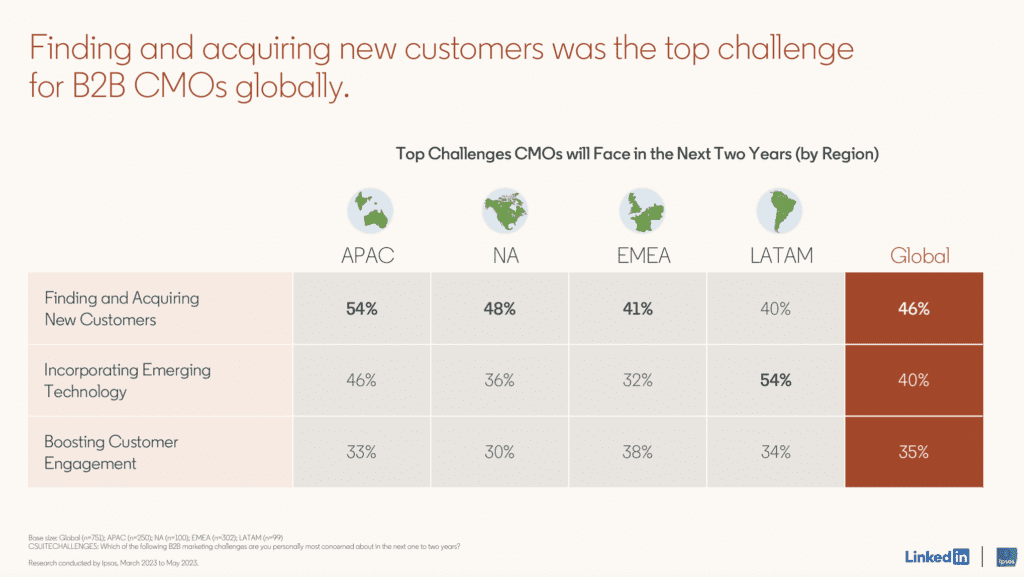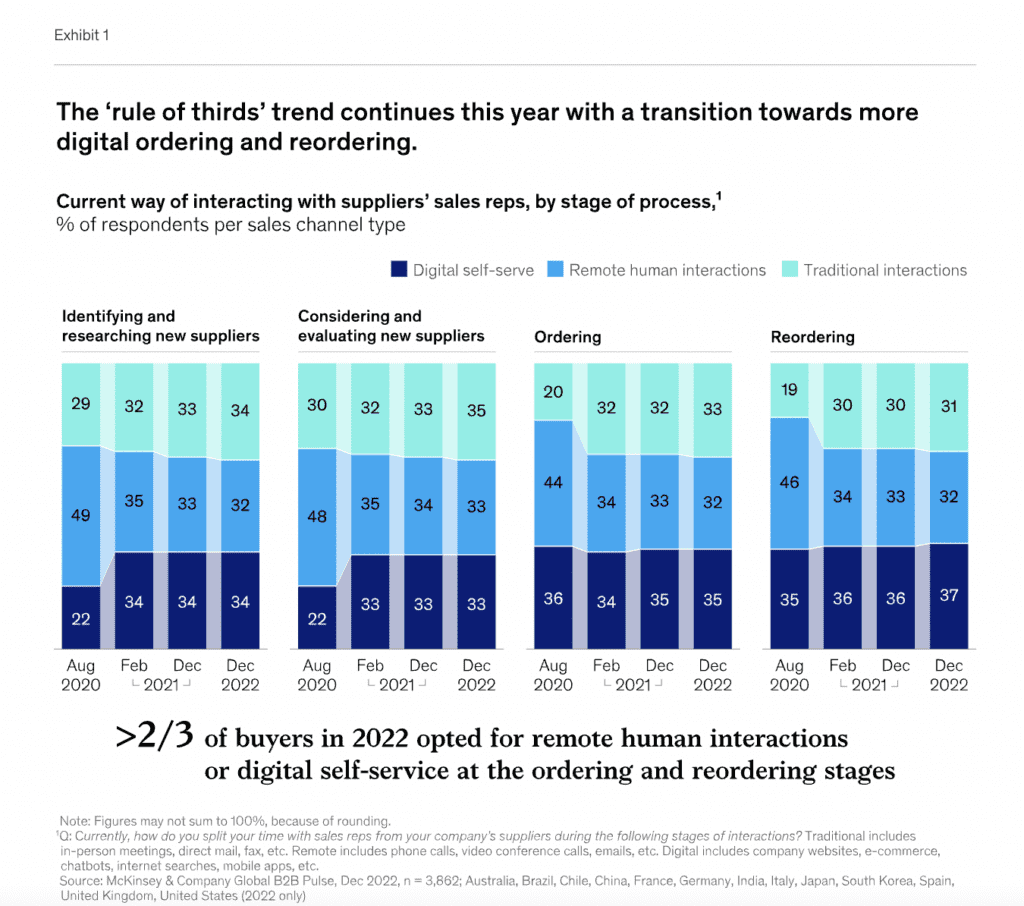Navigating the landscape of B2B requires a deep understanding of the trends, stats and research shaping the industry.
I’ve compiled research from LinkedIn’s latest research reports, Bain, McKinsey, eMarketer, Content Marketing Institute, Foundation Marketing and more. The resource below is an extensive collection of data, research and insights surrounding the state of B2B in 2024. I’ve compiled this research from only the most trusted, authoritative and reliable sources for B2B data.
The global B2B ecommerce market is poised to reach $20.9 trillion in 2024.
B2B Social Media Stats
80% of B2B brands use LinkedIn as their primary social media platform.
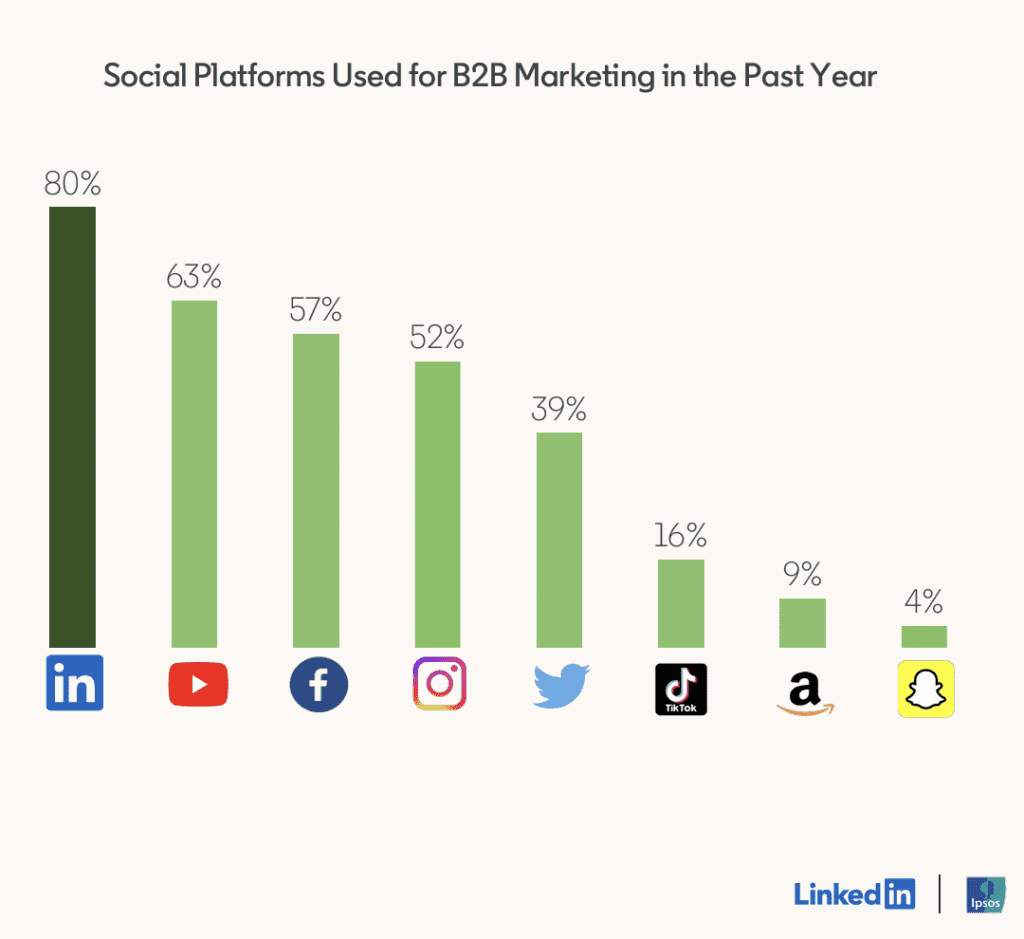
80% of B2B brands use LinkedIn as their primary social media platform. YouTube is the second most frequently used social media platform by B2B marketing teams with a 63% adoption. The third and fourth most frequently used B2B social media marketing channels are Facebook and Instagram at 57% and 52% respectively.
Meta properties (Instagram & Facebook) are the second & third most useful B2B social media channel.
YouTube included by many marketers who took part in this survey as a primary channel for social media. It’s important to note that YouTube is as much of a social media network as Netflix is.
My perspective on this would be that YouTube is accidentally being designated a social media platform when it’s better suited as a comparison to Google as a search engine. Although YouTube may not be a traditional social media platform, it still holds significant importance for B2B marketers.
LinkedIn has become the go-to platform for B2B brands to connect with potential clients and build professional relationships. With its focus on business networking and professional development, LinkedIn offers a unique opportunity for B2B companies to showcase their expertise and establish thought leadership in their industry.
I’m not alone in believing that LinkedIn is the primary channel of choice for B2B brands. In a study published by eMarketer that was originally conducted by Hootsuite in a 2024 Social Media Trends report – marketers ranked LinkedIn as the # 1 channel to deliver a positive return on investment followed by Instagram:
In the 14th annual Content Marketing Survey conducted by Content Marketing Institute & Marketing Profs, the organic social media platform that delivers the best value for organizations was LinkedIn.
84% of all B2B marketers who took part in the survey identified LinkedIn as the # 1 channel for driving value for their organizations.
YouTube, on the other hand, allows B2B brands to create educational and informative content that can reach a wider audience. This video-sharing platform is particularly effective for demonstrating complex products or services in action, as well as providing valuable insights and tutorials. The visual nature of YouTube makes it an ideal channel for engaging with potential customers and building brand awareness.
Facebook and Instagram are also important platforms for B2B companies, as they can help to humanize a brand and connect with potential clients on a more personal level. By sharing behind-the-scenes content, company updates, and employee stories, businesses can showcase their culture and values, which can resonate with potential clients looking for a trustworthy and relatable partner.
X (formerly known as Twitter) is another valuable platform for B2B companies, as it allows for real-time engagement and conversations with industry leaders and potential clients. With its character limit, X forces brands to be concise and creative in their messaging, making it an effective channel for promoting new products or services, sharing industry news and insights, and participating in relevant hashtags and discussions.
B2B Video Stats
63% of B2B content marketers use YouTube.
YouTube exists in more than 100 different countries. (Foundation / YouTube Report)
Yet only 7% of marketers say that their business uses videos to their full potential. (Source: ContentMarketingInstitute)
The reason why YouTube should be considered a search engine is because it’s often used for that purpose. Every single day people are looking to YouTube to discover new products, brands and services. In a study conducted by Google, they found that 90% of people surveyed have discovered new brands and/or products on YouTube.
In the first quarter of 2024, YouTube’s global advertising revenue reached $8.1 billion, marking a 21% surge from the same period in 2023. Renowned as one of the largest online video platforms globally, YouTube continues to dominate the digital space with creators like Mr. Beast having over 100M subscribers at the time of this report.
90% of people discover new brands or products on YouTube.
This statistic is a testament to the power of YouTube as a search engine. With over 2 billion monthly active users, it’s no surprise that people are turning to YouTube not just for entertainment, but also for product research and discovery.
Here’s a few YouTube specific stats to note:
- YouTube boasts a staggering 2.49 billion monthly active users, with over 80 million paid subscribers across its Premium and Music services.
- More than a third of the global population visits YouTube each month.
- 47% of the worldwide online population engage with YouTube as monthly active users.
Sources: YouTube
But what sets YouTube apart from traditional search engines like Google or Bing?
One of the main reasons is its visual nature. Unlike text-based search engines, YouTube offers engaging video content that allows viewers to see products in action and get a better understanding of their features and benefits.
Another advantage of using YouTube as a search engine is its recommendation algorithm. By analyzing user behavior and preferences, YouTube is able to suggest relevant videos based on an individual’s interests and viewing history. This makes it easier for users to discover new brands and products that they may not have come across through traditional search methods.
Furthermore, YouTube videos also allow for more authentic and relatable content. Many users turn to YouTube for reviews, unboxings, and tutorials on products they are interested in. This user-generated content offers a level of credibility that traditional search engines may not provide.
In a recent Hubspot report, 17% of marketers identified that short-form videos as a trend delivering ROI:
The second most common trend delivering ROI for these respondents was content that showed their brand values.
93% of B2B buyers say video is important in building trust in a brand. (Brightcove)
25% of marketers have decided to invest in podcasts as part of their content marketing strategy. (Source: HubSpot)
B2B Marketing Investment
In a study conducted by LinkedIn amongst B2B marketers, 52% of marketers believe their budgets would increase by 1-24% in 2024.
24% of marketers believed that their budgets would stay the same in the upcoming year.
The Center for Exhibition Industry Research (CEIR) announced today that the U.S. business-to-business (B2B) exhibition industry continues to rebound, recording further improvement in the first quarter of 2024. Continued improvement in metrics outcomes for completed events – especially the strong rebound of exhibition attendance – boosted the Q1 2024 Index value to 92.3. As expected, the CEIR Total Index – a measure of overall exhibition performance – continues to recover, surging 4.3% from a year ago.
But what about the other 40% of marketers?
Where are they investing their marketing dollars and efforts? In a study conducted by LinkedIn & Ipsos, B2B marketers identified in-person events & video content to be the two top marketing techniques to be invested in. In-person events was identified as the marketing technique of choice for 60% of all marketers followed by video at 59%.
Here’s the chart showing the average investment plans for B2B marketers based on the techniques they can utilize:
The third most identified technique of investment was thought leadership content.
This includes sharing industry news and insights, participating in relevant hashtags and discussions, and positioning oneself as an expert in the field. With 57% of B2B marketers planning to invest in this area, it’s clear that thought leadership is becoming a crucial component in B2B marketing strategies.
For 2024, half of marketers plan to increase investment in content marketing going forward. (Source: Optinmonster)
So why are more marketers investing in thought leadership content?
The answer lies in the changing landscape of B2B buying behavior.
By establishing yourself as a thought leader, you can build trust with potential buyers and differentiate yourself from competitors. This not only helps you generate leads but also retain the customers that you have already acquired.
According to 53% of B2B marketers, videos & case studies produce the best results.
The two most effective content marketing assets for B2B marketers to produce are case studies and video content. According to a study conducted by Marketing Profs & CMI, 53% of marketers selected both case studies / customer success stories and videos as the type of content that produced the best results for their organization.
According to 84% of B2B marketers, content marketing helped in building brand awareness (CMI)
When measuring the success of B2B marketing efforts, Brand Health is one of the primary focuses to drive brand awareness. This is shown in a study conducted by LinkedIn where out of 1,577 respondents 50% of them identified Brand Awareness & Reputation Surveys as the #1 source for brand health measurement.
The second most popular metric for measuring B2B brand health was website traffic at 48%.
One platform that often gets overlooked in B2B marketing strategies is X. While most people associate Twitter with personal use or B2C marketing, it can also be a valuable tool for B2B companies. Here’s why:
- Number of users worldwide: 415 million
- Monthly active users: 335.7 million
- Worldwide usage ranking: 12th most popular social network
B2B Challenges
84% of B2B marketers, alignment and correlation of data across platforms is their primary challenge (CMI)
The primary hurdle faced by B2B marketers in assessing content performance is the integration and correlation of data across various platforms (84%). This is closely followed by the challenge of deriving insights from data (77%), aligning performance data with objectives (76%), setting organizational goals (70%), and the need for adequate training (66%).
Here’s the results from a study conducted by CMI surrounding B2B marketers challenges with content measurement:
When it comes to objectives, 84% of B2B marketers identified content marketing as a key channel for boosting brand awareness in the past year. Additionally, 76% acknowledge its role in lead generation, while 63% appreciate its impact on nurturing subscribers and audiences. Furthermore, 58% recognize its contribution to driving sales and revenue, a significant increase from 42% in the preceding year.
When asking marketers what challenges they struggle with, Hubspot’s Marketing Report found that 16% struggled finding new content ideas. The second most common challenge for marketers was generating content that drove results and engagement.
These are promising metrics for every content marketer and solidifies why the investment that B2B brands are making into thought leadership continues to rise.
76% of marketers identified content marketing as playing a key role in lead generation
Tracking the ROI of content marketing may pose a challenge, yet it remains within reach. This is particularly crucial when your sales and marketing teams are aligned.
While your marketing team may attract numerous visitors to your website, without a clear understanding of the ideal customer profile or the factors that drive conversions, the influx of traffic may remain just that – mere traffic.
When CMOs were asked by LinkedIn what skills were the most important for the CMO role today, 59% said creative strategy & execution. The majority of the respondents believed that marketing technology / data analytics mastery would be the most important skill for the future:
When it comes to content promotion, 73% of marketers use social media via organic posting (Source: SEMrush)
B2B Website Stats
The number one investment that marketers tend to make is in their website. The development of pages, blog posts, redesigns, automation, development and more lead to the website being the second most expensive line item on a marketing teams budget. The most expensive line item tends to be paid media budget which has the main purposing of getting people to see the pages that exist on their site.
In a 2024 study conducted by Hubspot, the website, blog and SEO efforts conducted by marketing teams was reported to drive the most results. This channel was tied with social media shopping tools which was seems to be more specific to B2C than a B2B audience:
Marketing teams must have a clear understanding of their target B2B buyer and how to craft compelling content that motivates them to convert into leads. These insights are most effectively gleaned from sales teams actively engaging with customers.
So why do some B2B brands still avoid the investment into content marketing?
58% of B2B content creation teams suggest that a lack of resources is their most significant challenge.
This could be attributed to a lack of alignment between leadership and marketing teams.
When leadership teams are not understanding the value of the content marketing process, there can be a significant disconnect between and that leads to a lack of investment.
B2B & Generative AI
In an AI Marketing study, the Foundation team found that the number one tool used by marketers was ChatGPT from OpenAI. The second most popular tool was Canva followed by Grammarly. The most popular AI related writing software being used was JasperAI.
When content marketing institute asked their audience how B2B Marketers were using Generative AI for content tasks 51% said brainstorming new topics:
45% of B2B marketers use Generative AI to research headlines and keywords.
This is a staggering number because it’s been proven that AI tools hallucinate when making recommendations around things like keyword volume. In a study that I recently conducted, I found the difference between ChatGPT projected search volume and Ahrefs search volume to be drastically significant. Here’s a sample showing the gap:
This is why in the study Foundation conducted almost 50% of marketers identified “False Information” as the top risk associated with AI.
Content Marketing Institute found something similar with 36% of B2B marketers saying accuracy concerns are the reason they don’t use them:
So what do B2B marketers use AI for?
In the Foundation study, 85% of all respondents identified that they use AI tools in the content creation process:
Yet, 42% of marketers believe that AI content is a bit worse than human created content.
B2B Sales Stats
CMOs on a global level continue to point to finding & acquiring new customers as the top B2B challenge. According to an analysis conducted by LinkedIn throughout 2023, they found that 46% of global CMOs believed that finding & acquiring customers would be their top challenge in the next two years:
48% of North American CMOs viewed finding & acquiring new customers the # 1 challenge they would face.
Customers continue to seek a balanced mix of traditional, remote, and self-service channels, encompassing face-to-face interactions, inside sales, and e-commerce offerings. Notably, a rising trend is observed in online ordering and reordering, particularly evident in the Western European and Australian markets, with usage rates reaching up to 40% of total orders.
Gartner predicts that by 2025, 80% of B2B sales interactions between suppliers and buyers will occur in online channels.
One-third of 200 B2B buyers and sellers surveyed said they started their product search on Amazon.
B2B e-commerce has emerged as the foremost impactful sales avenue.
35% of respondents rank it as their top choice, surpassing in-person sales (26%), video conferences (12%), emails (10%), and phone calls (8%). Successful companies not only utilize digital self-service on their websites but also expand into e-commerce. For instance, 48% of winners engage in industry-specific marketplaces, while only 13% of losing companies do.
This showcases the importance of incorporating e-commerce offerings into B2B sales strategies.
What’s driving this shift towards e-commerce in the B2B world? One major factor is the rise of millennials in decision-making roles within companies. These digital natives are accustomed to online shopping and expect the same convenience and efficiency in their business transactions. Additionally, as technology continues to evolve, more user-friendly and robust e-commerce platforms have emerged, making it easier for businesses to make purchases online.
Wrapping Up
The state of B2B is one worth studying. The buyers journey has evolved and is continuing to change every single day.
More marketers are realizing how fragmented the industry is and more and more marketers are using data like those above to make better decisions. As someone who has worked closely with B2B brands on a global scale, I’ve never been more optimistic about what the future holds. The industry is ripe for innovation, change and more creativity. If you’re a marketer, executive or strategist looking to unlock new opportunities – B2B is ready for it.
If you’re a brand uncertain where to start. I hope the data here will help.
Sources:
https://business.linkedin.com/marketing-solutions/b2b-benchmark/2024


